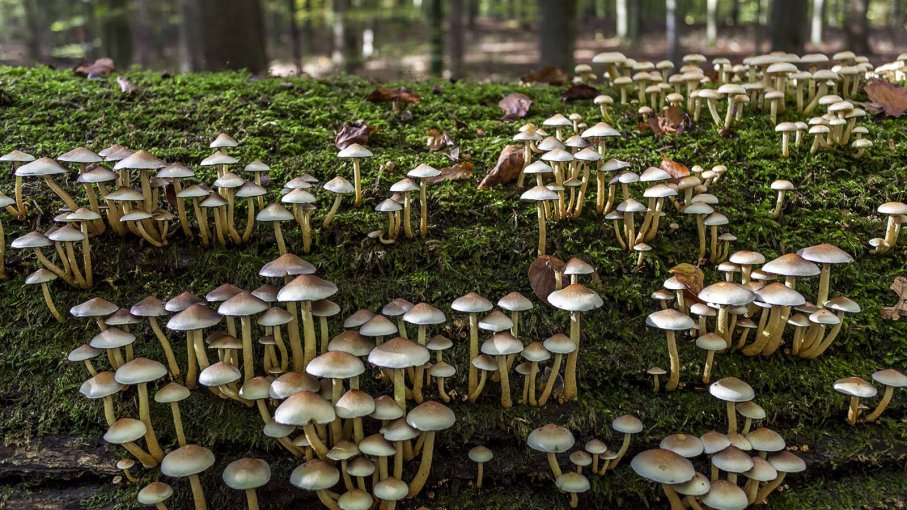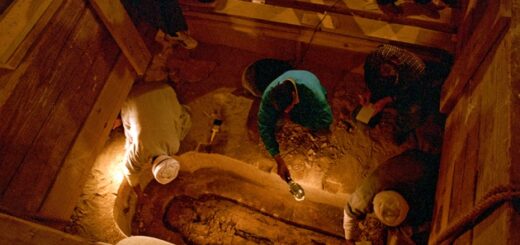Can Mushrooms Actually Help Save the Planet?

In college, Eben Bayer grew mushrooms under his dorm room bed. The mechanical engineering student, who had grown up on a Vermont farm, was convinced the fungus was one of nature’s most effective “technologies” and could be used to overhaul the way we make a range of everyday products.
Thirteen years later, his New York-based company Ecovative Design produces over a million pounds per year of its compostable mushroom-based alternative to Styrofoam. And Bayer is turning his mind to the next product on his list: fake meat.
Bayer believes mycelium ― the network of tissue that makes up the body of many fungi, a broad category that includes mushrooms ― could be a great, eco-friendly meat alternative. The fermented slabs can even be cut thin enough to make a “very compelling bacon.”
“We could do a thousand and one things with mycelium,” Bayer says.
Bayer is not alone in his belief in the magical power of mushrooms. Much of their appeal comes from the plethora of potential solutions they seem to offer to our many environmental problems.
meat alternative
Mmm. Is that bacon? Actually it’s not. It’s an eco-friendly meat alternative made from mushrooms.
ECOVATIVE
Is Fungi a Game-Changer?
There is now a slew of startups touting fungi as an environmental game-changer, able to make the construction industry greener, replace animal products in our food and clothes, and even clean up pollution and eat through waste. They say mycelium’s unique structure and chemical properties, combined with the fact that mushrooms are easy to grow, found all over the world and consume almost anything, make them the ideal building block for a wide range of applications. NASA is even thinking about building homes from fungus on Mars.
But while the buzz around fungus is getting louder, its impact on the ground is still relatively hard to spot. Mushroom-based leather, for example, has drawn attention as an alternative to animal skins, but is still limited to a tiny range of designers. And while mushroom-based materials, like the ones produced by Ecovative, have been talked up as a replacement for plastic for a decade, global plastic production is still booming (or at least was before the coronavirus pandemic).
For Peter McCoy, the author of “Radical Mycology: A Treatise on Seeing and Working with Fungi,” it’s strange that it has taken so long for fungi to gain attention given their status in nature. As neither plants nor bacteria nor animals, they can do certain things in the environment none of those groups can do, says McCoy, who is also the founder of a grassroots group working to spread awareness about the fungi field.
One unique function is that their threadlike tissue grows fast and in tight networks, lending itself to light and strong material suitable for a range of purposes. But perhaps even more important, McCoy says, is that they produce a cocktail of chemicals when digesting food or protecting themselves.
“That chemical soup ― which will vary by species or even the environment they’re in ― leads to a whole range of compounds that we don’t find anywhere else in the natural world,” says McCoy, pointing to penicillin as an example of the powerful substances they generate. “Fungi are nature’s greatest chemists.”
Deepening insights into these powers, combined with technological advances ― particularly in genetics ― have led to an explosion of interest in how to apply fungi’s “chemical mastery” to human systems, says McCoy. That encompasses products we might use, for example, to package goods, build houses and feed ourselves; and also processes that can help clean up our world, for example by breaking down environmental toxins and consuming plastic.
“For the first time in human history, we understand and can work with these organisms to greater degrees than has ever been possible,” he says.
Mycelium
Mycelium is the vegetative part of a fungus that consists of a mass of branching, thread-like hyphae and several startups are using it to create products like insulation.
KICHIGIN/SHUTTERSTOCK
Building Blocks With Mycelium
Ehab Sayed, the founder of U.K. biotech startup Biohm, shares that view. Scientists in the company’s London lab work to develop new strains of fungi by exposing batches to stimuli like differing light or humidity levels. In this process, known as directed evolution, the fungi rapidly evolve, for instance creating new enzymes, Sayed says. And when these adaptations look like they’ll be useful to humans in some way, the team clones the fungi and develops them further.
One product to come out of this process is a mushroom-based building insulation, made by feeding waste to mycelium. The company plans to launch it commercially this summer as an eco-friendly alternative to synthetic insulation materials, which Biohm says are carbon-intensive to manufacture, hard to recycle and pose a risk to health by emitting volatile organic compounds into buildings.
Biohm’s insulation will be expensive when it launches ― at around $30 per square meter (compared to an industry average of around $15). But the material will be cost-effective, according to Sayed, since its thermal conductivity is lower than conventional insulation, meaning less is needed to achieve the same result.
The company also expects the price to fall quickly as it scales ― Biohm is turning an old paper mill in southwest England into a vertical mushroom farm and plans to expand to the Netherlands and Portugal next year.
Working with mushrooms has key commercial advantages, Sayed says ― most obviously their ability to thrive on waste. Raw materials are usually a manufacturer’s main expense, but Biohm grows its mushrooms using other companies’ byproducts, such as timber shavings and grass clippings, which it is paid to collect, creating a “double revenue stream.”
Yet despite such selling points, making a success of fungal products in the real world is not always straightforward. In 2016, furniture giant IKEA announced plans to replace plastic foam with Ecovative’s mushroom packaging to great fanfare, but has since quietly dropped the scheme. The retailer said in an email to HuffPost that “it was not possible to scale production to make it viable at industry level.”
Evocative
Evocative is using mushrooms to replace packaging for all kinds of products, like this wine bottle mailer.
EVOCATIVE
Commercial Uses for Mushrooms
Part of the challenge, says Bayer, is to focus on areas where mushroom-based products can add value and be cost competitive, rather than trying to use them for everything. Attempting to displace throwaway plastic-foam cups ― mass-produced on an epic scale and value-engineered to be extremely cheap ― is a nonstarter, for example: “It’s a horrible application for our technology. [It’s] never going to be competitive. So someone else has to solve the cup problem,” he says.
But even when they believe they have the right solution, some startups have found a lack of appetite for investing in new products and processes in incumbent industries.
Life Cykel is an Australian company that started out growing gourmet mushrooms off of waste coffee grounds collected from local cafes and has since expanded into the health field, with a range of mushroom extracts that claim to boost immunity. Customers include elite athletes and bee farmers, who feed the extract directly to their bees.
Company founder Julian Mitchell believes Life Cykel could also help tackle the problem of waste in the fashion industry. In small-scale trials, he says, the team has successfully used mushrooms to break down discarded clothing. But Mitchell says that scaling this to the point where it could have an impact would need much greater investment from clothing companies ― and commitment to solving their waste problem ― than is currently visible. “It comes down always to capital investment and are those companies prepared to invest in that or are they happy just to send it off to landfill?”
Udeme John Dickson, an environmental scientist at Nottingham Trent University in the U.K., has observed a similar challenge in the area of mycoremediation ― the use of fungi to break down pollution in soil or other environments. The idea that the all-consuming hunger of fungi can be harnessed to clean up waste already polluting land and waterways has excited scientists for decades. But Dickson says the remediation industry has so far failed to invest in refining the method to the point it can be widely commercialized.
Both Mitchell and Dickson would like to see higher levels of government intervention to incentivize corporate investment in fungi-based approaches — such as higher taxes on dumping waste in landfill.
But others believe a more radical restructuring of our global manufacturing industry ― one that takes power away from big companies ― may be required to create a world where mushroom-based products flourish.



 Creators of mankind
Creators of mankind Description of “Tall white aliens”
Description of “Tall white aliens” Where they came from?
Where they came from? About hostile civilizations
About hostile civilizations The war for the Earth
The war for the Earth “Tall white aliens” about eternal life
“Tall white aliens” about eternal life Video: “Nordic aliens”
Video: “Nordic aliens” Aliens
Aliens Alien encounters
Alien encounters The aliens base
The aliens base UFO
UFO Technology UFO
Technology UFO Underground civilization
Underground civilization Ancient alien artifacts
Ancient alien artifacts Military and UFO
Military and UFO Mysteries and hypotheses
Mysteries and hypotheses Scientific facts
Scientific facts


















